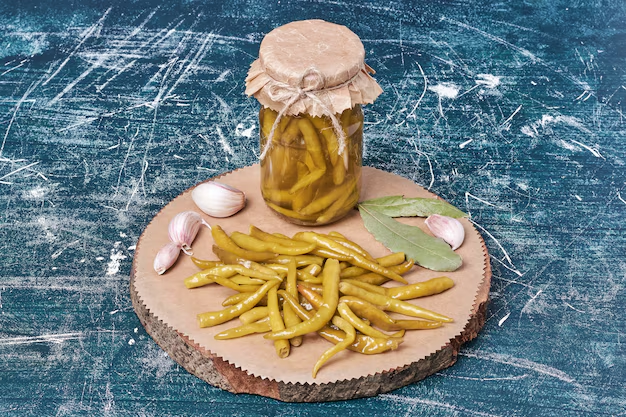How Long Can You Keep Homemade Pickles Fresh in the Fridge?
It's the little things in life that can bring us joy, and few things are more satisfying than popping open a jar of homemade pickles for that perfect crunchy bite. Whether you've canned them from fresh cucumbers, carrots, or other veggies, knowing how long these homemade delights last in the refrigerator is key to enjoying them safely. Sit back, and let's dive into the engaging world of homemade pickles and their shelf life!
The Lifespan of Homemade Pickles
When it comes to homemade pickles, a myriad of factors affects how long they can stay crisp and tasty in your refrigerator. Understanding these elements can help you maximize their shelf life and avoid any unpleasant surprises.
Ingredients Matter
The ingredients you choose play a significant role in how long your homemade pickles last. Vinegar, salt, and sugar are common components used in pickling recipes, and they're not just for taste. These ingredients act as preservatives. Here's how they help:
- Vinegar: Its acidity fights off spoilage-causing bacteria, enhancing the pickle's longevity.
- Salt: This not only adds flavor but also draws out moisture from the veggies, creating an inhospitable environment for bacteria.
- Sugar: Especially in sweet pickles, sugar aids in preservation by stabilizing the acidity level.
How They Are Stored
Proper storage is key to keeping pickles fresh. Here are some storage tips for longer-lasting homemade pickles:
- Use airtight containers: Once opened, make sure the pickles are sealed tightly to maintain freshness.
- Maintain a consistent temperature: Keep them in the coldest part of your fridge, such as the bottom shelf, to slow down the fermentation and spoiling processes.
Estimating Shelf Life
While there's no exact expiration date, homemade pickles can generally last in the refrigerator for 1 to 2 months, depending on the recipe and storage conditions. Keep an eye (and nose) out for any signs of spoilage.
Recognizing Freshness Versus Spoilage
Knowing how to identify if your pickles are still good or heading south is crucial for enjoying them safely. Here are some telltale signs to look for:
Signs Your Pickles Are Still Good
- Crisp Texture: A hallmark of a fresh pickle is its satisfying crunch.
- Vibrant Color: Bright green for cucumbers or retained original colors in other vegetables.
- Tart and Tangy Smell: Should smell fresh without any off-putting or unusual odor.
Indications of Spoilage
- Mushy Texture: If they feel soft or slimy, it's time to toss them.
- Cloudy Brine: Slight cloudiness can be normal, but if it's paired with other signs like a sour smell, beware.
- Off Smell: A sour or rotten scent is a clear signal to discard the pickles.
Quick Tip Summary 🌟
- 🥒 Keep it Crisp: Regularly check texture and color.
- 🔍 Watch for Signs: Stay alert for texture loss, strange smells, or changes in appearance.
- 🚮 When in Doubt, Throw it Out: Better safe than sorry when spoilage is suspected!
Maximizing Pickle Longevity
With the right practices, you can make the most out of your pickle jar. Here's how you extend that crisp crunch as long as possible:
Recipe Adjustments
Consider altering your recipe slightly to prolong shelf life:
- Increase Vinegar: Add a bit more vinegar than called for in recipes to boost preservation.
- Use Pickling Salt: It's purer and better suited for preserving than regular table salt.
Storage Hacks
Here are a few storage hacks that are not only practical but also effective:
- Layer the Pickles: If they're immersed fully in brine, they stay crisp longer.
- Use Smaller Jars: This minimizes exposure to air each time you open the jar.
Enjoying Pickles Beyond the Jar
Pickles are more than just a condiment. Why not explore ways to infuse them into your daily meals?
Culinary Uses
- Sandwich Toppers: Add tangy zest to your favorite subs or burgers.
- Salads: Chop pickles finely and mix them into potato or tuna salads for an extra kick.
- Dips: Blend them into creamy dips to wow your party guests.
Relish New Recipes
If every bite of your homemade pickles inspires more than just immediate satisfaction, consider branching out with these ideas:
- Pickled Infused Cocktails: Enhance your Bloody Mary with pickle brine.
- Cooking with Brine: Use leftover brine as a marinade for chicken or pork for flavorful meat.
Quick Recipe Ideas 🥗
- 🍔 Pickle-Infused Avocado Spread: Perfect on toast or with chips.
- 🌮 Pickle Tacos: Try a topping on fish tacos for a tangy twist.
- 🍰 Pie Crusts with Brine: Use a hint of brine for savory pie crusts.
The Magic of Fermented Pickles
Let's take a moment to appreciate the art and science behind naturally fermented pickles. This timeless technique involves using saltwater brine and naturally occurring bacteria to ferment veggies over time.
Benefits of Fermentation
- Flavor Complexity: Fermented pickles develop a depth of flavor that standard brine can't achieve.
- Gut Health: They're packed with probiotics, which are beneficial for digestive health.
DIY Fermentation
Here's a simple guide:
- Prep Veggies: Wash them thoroughly.
- Make Brine: Use a salt-to-water ratio typically recommended in fermentation recipes.
- Submerge: Ensure veggies are fully submerged in an airtight container.
- Wait: Fermentation takes a few days to weeks.
🍶 Fermentation Highlights
- 🌿 Experiment with Herbs: Dill, garlic, or chili pepper for added flavor.
- ⏳ Patience is Key: The taste improves over time.
Maintaining Best Practices
Keeping quality in mind:
- Sterilize Containers: Before use, boil containers to eliminate bacteria.
- Regular Check-Ins: Periodically inspect and taste-test your pickles.
With these tips, you'll not only ensure the tastiest pickles possible but also a safer, enjoyable culinary journey. Now, you can relish every bite of your homemade pickles, savoring the freshness that comes with each crunch!
